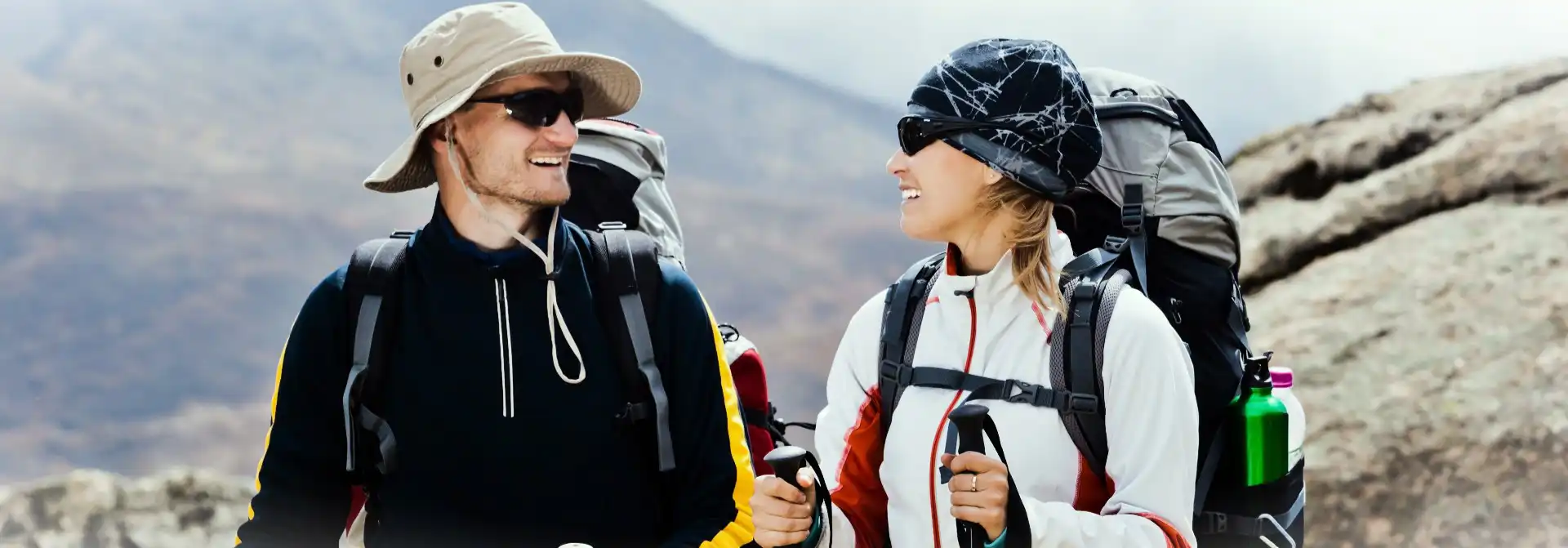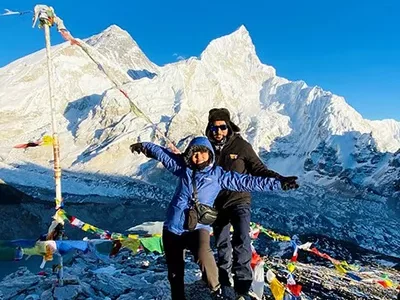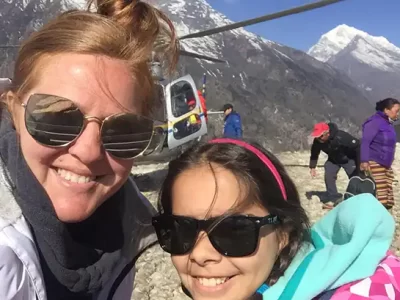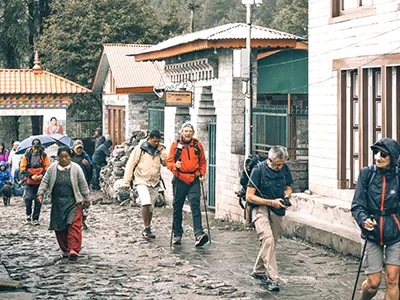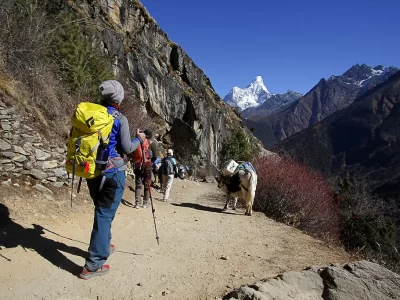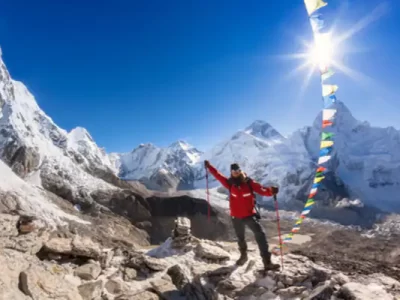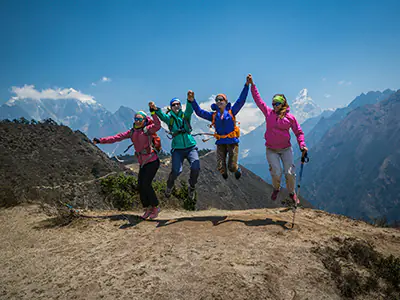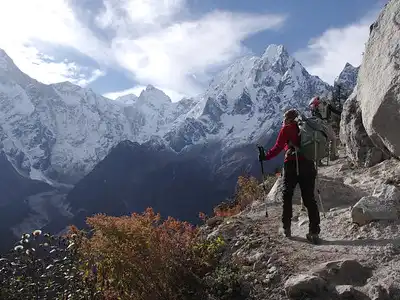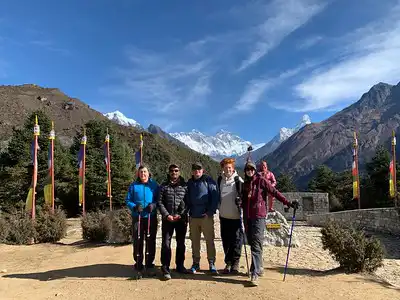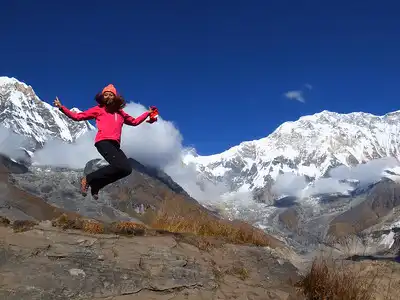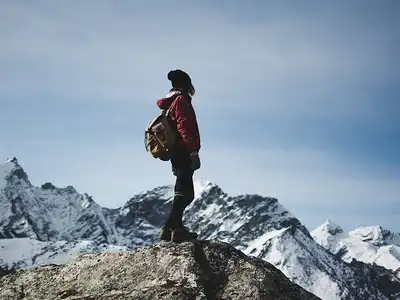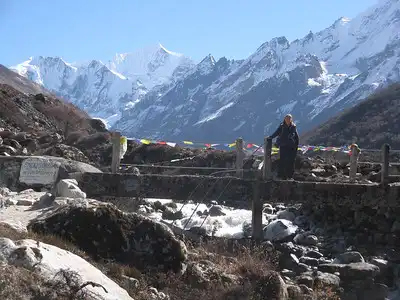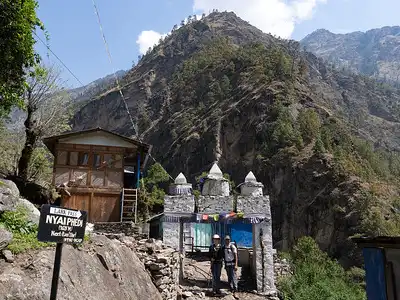Travelers on the iconic Everest Base Camp trek navigate the heart of the Nepalese Himalayas, reaching the base of Mount Everest, the world’s tallest peak. This trek, spanning 15 to 17 days and covering roughly 130 kilometers round trip, starts in Lukla, a small town reachable by flight from Kathmandu.
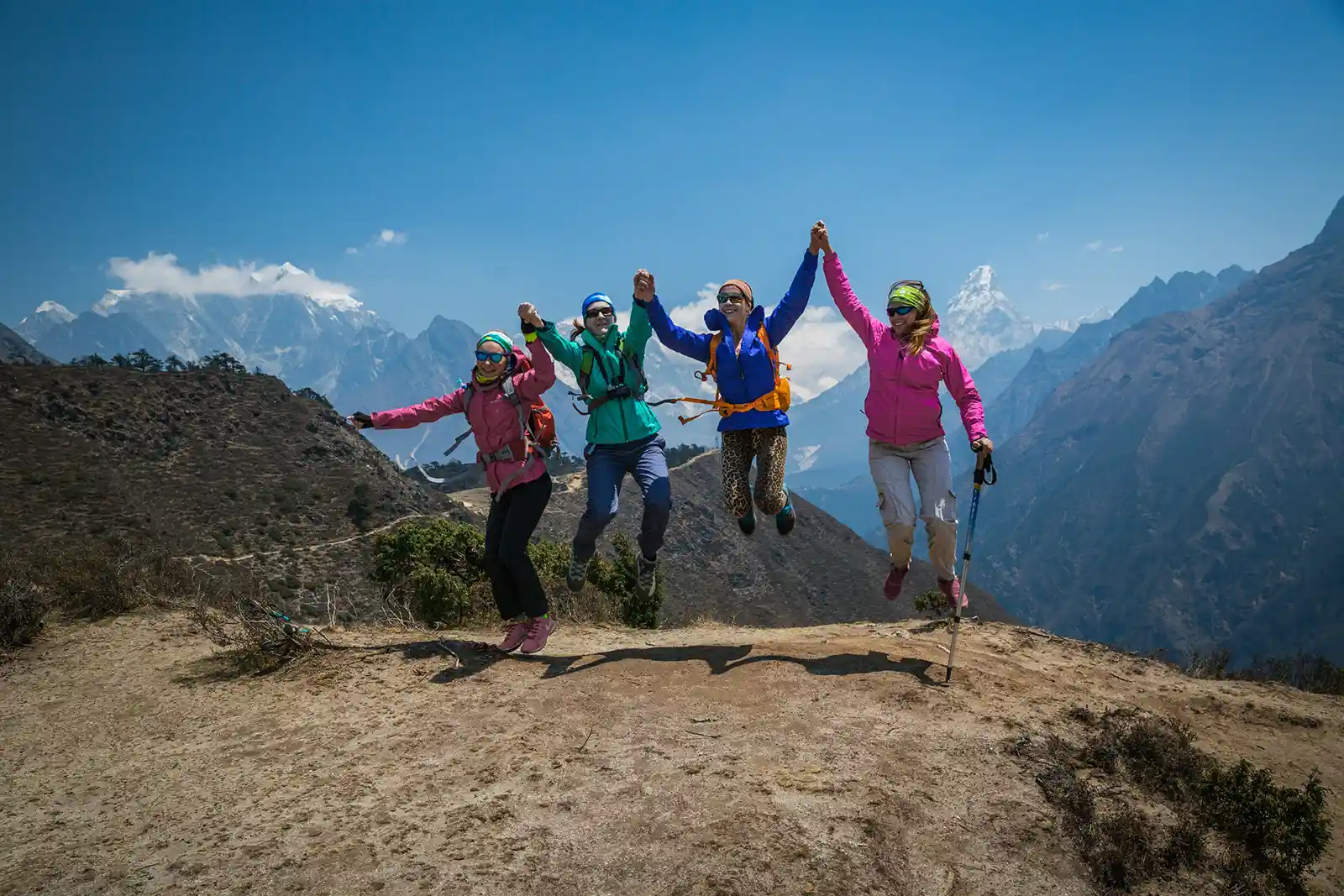
Trekkers navigate through picturesque villages, monasteries, and rhododendron forests, enjoying continuous views of the towering snow-capped peaks. This trek offers a blend of physical challenges, cultural immersion, and stunning landscapes. I’d like you to please read this article carefully for the Everest Base Camp Packing List.
Everest Base Camp Trek
Everest Base Camp Trek with Helicopter Return
Luxury Everest Base Camp Trek
Importance of Packing Correctly for the Trek
Weather Variability: The unpredictable Himalayan weather, with its wide temperature variations and rapid changes, necessitates proper gear to ensure safety and comfort under all conditions.
Altitude Challenges: Trekkers face real risks of altitude sickness at elevations over 5,000 meters. Carrying medications, hydration equipment, and energy-rich foods is essential to manage high-altitude effects.
Remote Location: The trek’s remote stretches require self-sufficiency, as supplies are limited. Proper equipment and essentials prepare trekkers for situations ranging from minor injuries to unexpected overnight stays.
Sustainable Travel: Trekkers must pack responsibly, choosing reusable and eco-friendly items to minimize environmental impact in the pristine Himalayan environment.
Photographic Opportunities: The trek offers content creators and photography enthusiasts unmatched scenic and cultural captures. The right camera equipment allows for effective documentation without burdening the trekker with excess weight.
Understanding the Climate of Everest Base Camp
Everest Base Camp (EBC) presents a climate that shifts dramatically across the year, shaped by its extreme altitude and rugged terrain. These shifts demand careful planning and packing from trekkers.
Weather Conditions Throughout the Year
Spring (March to May)
From March to May, the Everest Base Camp welcomes trekkers with some of its best conditions for hiking. During this period, daytime temperatures hover between 10°C and 15°C, offering a pleasant environment for extended treks. Although temperatures drop below freezing at night, the skies remain clear, providing excellent visibility of the breathtaking mountain landscapes.
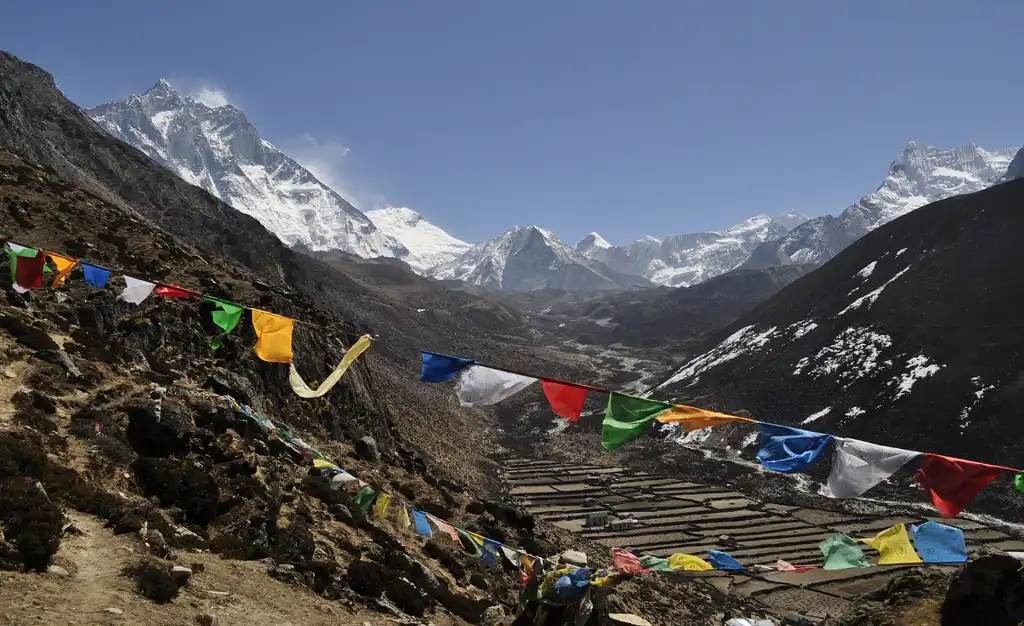
The trails come alive with the bright hues of blooming rhododendrons, enhancing the trek’s visual appeal as the winter snow recedes. Spring draws numerous explorers to the Everest Base Camp trail, making it a popular trekking season. The increase in trekkers often leads to congested paths and fully booked accommodations, so early reservations are advisable.
The weather is generally stable in spring, reducing the frequency of weather-related emergencies, but trekkers should always be ready for unexpected weather shifts. During this time, helicopter rescues and tours operate reliably and frequently, ensuring both the safety and enjoyment of adventurers, making it a prime season for those in search of both thrills and security.
Summer/Monsoon (June to August)
From June to August, the Everest Base Camp region undergoes its monsoon season, characterized by daily temperatures ranging from 15°C to 20°C. High humidity and regular, heavy rains during these months render the trails slippery and frequently shroud the spectacular mountain vistas in thick clouds.
These moist conditions pose challenges to trekker endurance and necessitate heightened safety vigilance due to slippery pathways and limited visibility. During the monsoon, fewer trekkers choose to navigate the trails, which typically results in more available accommodations and less crowded paths. However, this advantage is balanced by an increased risk of landslides and trail washouts, requiring trekkers to monitor weather reports and trail conditions actively.
Helicopter operations are scarcer and riskier in these conditions, often leading to delayed emergency services. Nevertheless, for those well-prepared, the monsoon season offers a distinctively tranquil trekking experience despite the inherent challenges.
Autumn (September to November)
From September to November, Everest Base Camp experiences exceptionally stable weather, with clear skies and daytime temperatures comparable to those in spring. As autumn progresses, the temperatures at night begin to drop below freezing, particularly as November nears, marking the transition to colder days.
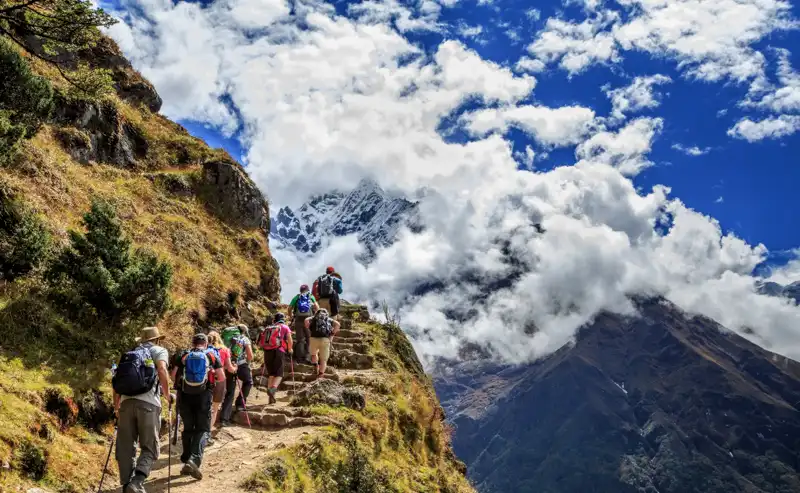
This change not only accentuates the crisp clarity of the autumn skies but also signals trekkers to prepare for cooler weather ahead. Autumn is also a peak trekking season, attracting a large number of hikers to the trails.
The dependable and clear weather during these months ensures that helicopter services are both consistent and frequent, aiding in prompt rescues and providing memorable scenic tours. With the trails becoming busy, trekkers need to plan their trips well in advance to secure the necessary accommodations and services for a seamless and enjoyable adventure.
Winter (December to February)
From December to February, Everest Base Camp enters its coldest season, with daytime temperatures ranging from 5°C to 10°C and nighttime temperatures often falling below freezing. Snowfall during this period not only beautifies the landscape but also complicates trekking with slippery trails and obscured paths, demanding careful navigation and thorough preparation from trekkers.
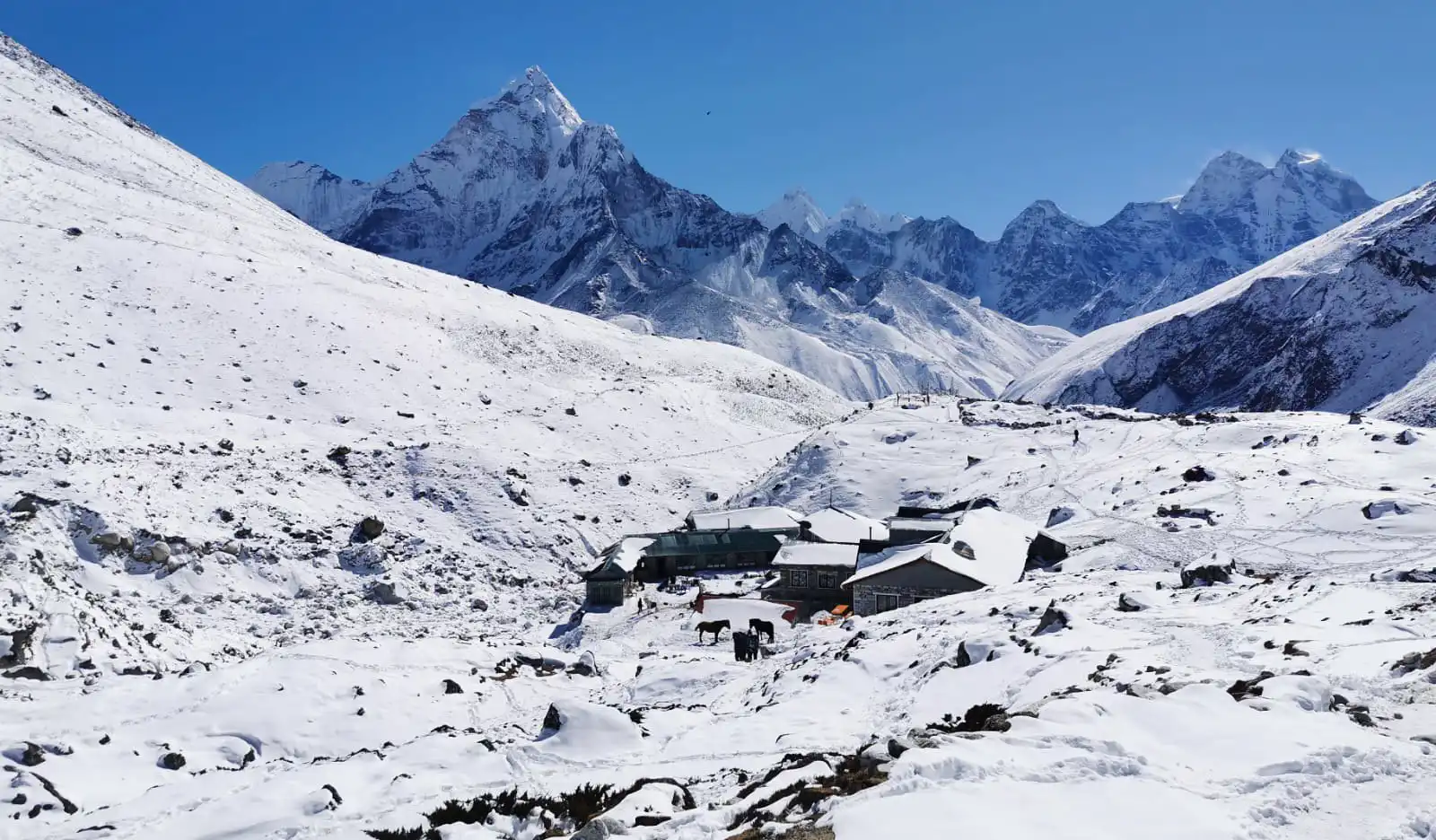
As winter intensifies, the risks of avalanches and severe cold discourage many casual trekkers from starting this adventure. As a result, the trails see fewer hikers, providing a more isolated trekking experience. However, this isolation requires trekkers to be more self-sufficient and well-prepared. Additionally, helicopter services decrease in frequency and reliability due to the harsh conditions, which can slow down emergency response times.
Altitude Considerations and Their Impact on Packing
Ascending above 5,300 meters (17,400 feet) to Everest Base Camp thins the air and lowers oxygen levels significantly. These high-altitude conditions dictate specific gear requirements.
Acclimatization Gear: To adjust to high elevations, trekkers must carry hydration systems to fend off altitude sickness, with a strong emphasis on fluid intake.
Temperature Regulation: The rarefied atmosphere at high elevations makes temperature control tricky, causing sharp shifts from sun to shade. Essential to packing are layered clothes that trekkers can easily don or doff to regulate body heat.
Sun Protection: High altitudes intensify UV radiation exposure, necessitating high-SPF sunscreen, protective lip balm, and quality sunglasses to guard against sunburn and eye damage.
Sleeping Arrangements: The trek demands sleeping bags suitable for low temperatures and insulated pads, given the often unheated accommodations at higher altitudes.
Everest Base Camp Short Trek
Jiri to Everest Base Camp Trek
Everest Base Camp Trek for Beginners
Essential Everest Base Camp Trek Packing List
Securing the right gear and clothing becomes a cornerstone for a triumphant Everest Base Camp trek. Trekkers must gear up for the extreme and ever-changing weather by strategizing their layering and choosing the proper footwear and headgear.
- Base Layer: Managing moisture is the primary goal of the base layer. Lightweight, breathable materials like merino wool or synthetic fabrics should make up this layer, wicking sweat off the body to keep the wearer dry and warm. Cotton, which holds moisture and may cause cooling, should be avoided.
- Mid Layer: Acting as the main insulator, the mid layer retains body heat to combat the cold. Ideal options include fleece jackets or wool sweaters, which offer insulation while allowing breathability. For extra insulation in colder weather, one can add a lightweight down or synthetic jacket.
- Outer Layer: The critical outer layer needs to protect against wind, rain, and snow. Essential are durable, waterproof, and windproof jackets and pants. These garments should have ventilation zips for temperature control and to prevent overheating.
Footwear: Choosing the Right Hiking Boots and Socks
Hiking Boots: The selection of sturdy, waterproof boots with good ankle support is crucial for comfort and foot protection.
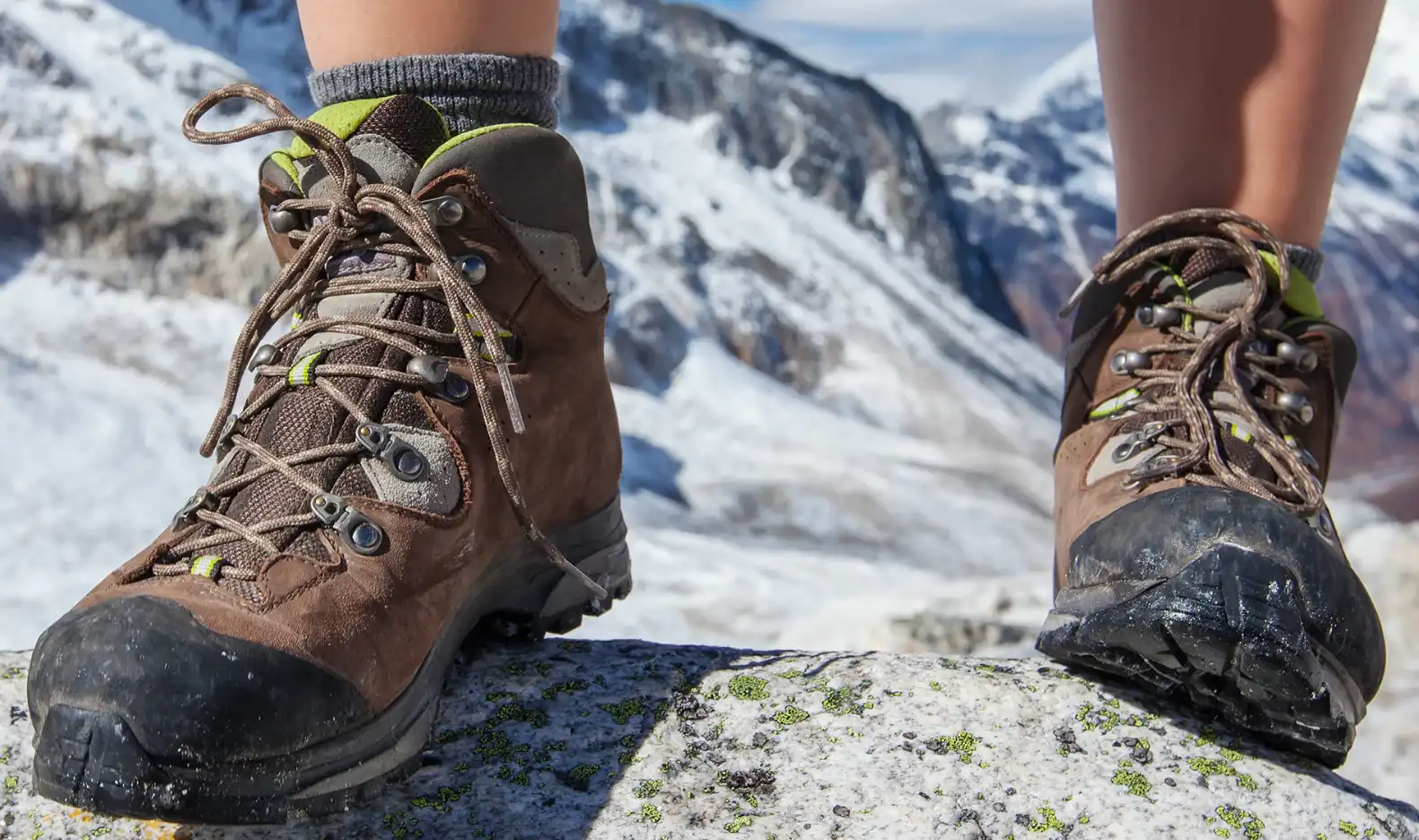
Trekkers should break in their boots before the trek to minimize blisters and discomfort.
Socks: Complementing the boots with trekking-designed, high-quality socks, preferably made from wool or synthetic blends, aids in moisture wicking and keeps the feet dry. It’s wise to carry multiple pairs of varying thicknesses to adapt to temperature changes and maintain freshness.
Headgear
Hats: Essential for warmth and sun protection, a good hat should be lightweight and breathable with a brim for sunburn protection, while a wool or synthetic beanie will provide warmth in colder environments.
Sunglasses: Given the high-altitude UV risks, sunglasses with UV protection become a necessity.
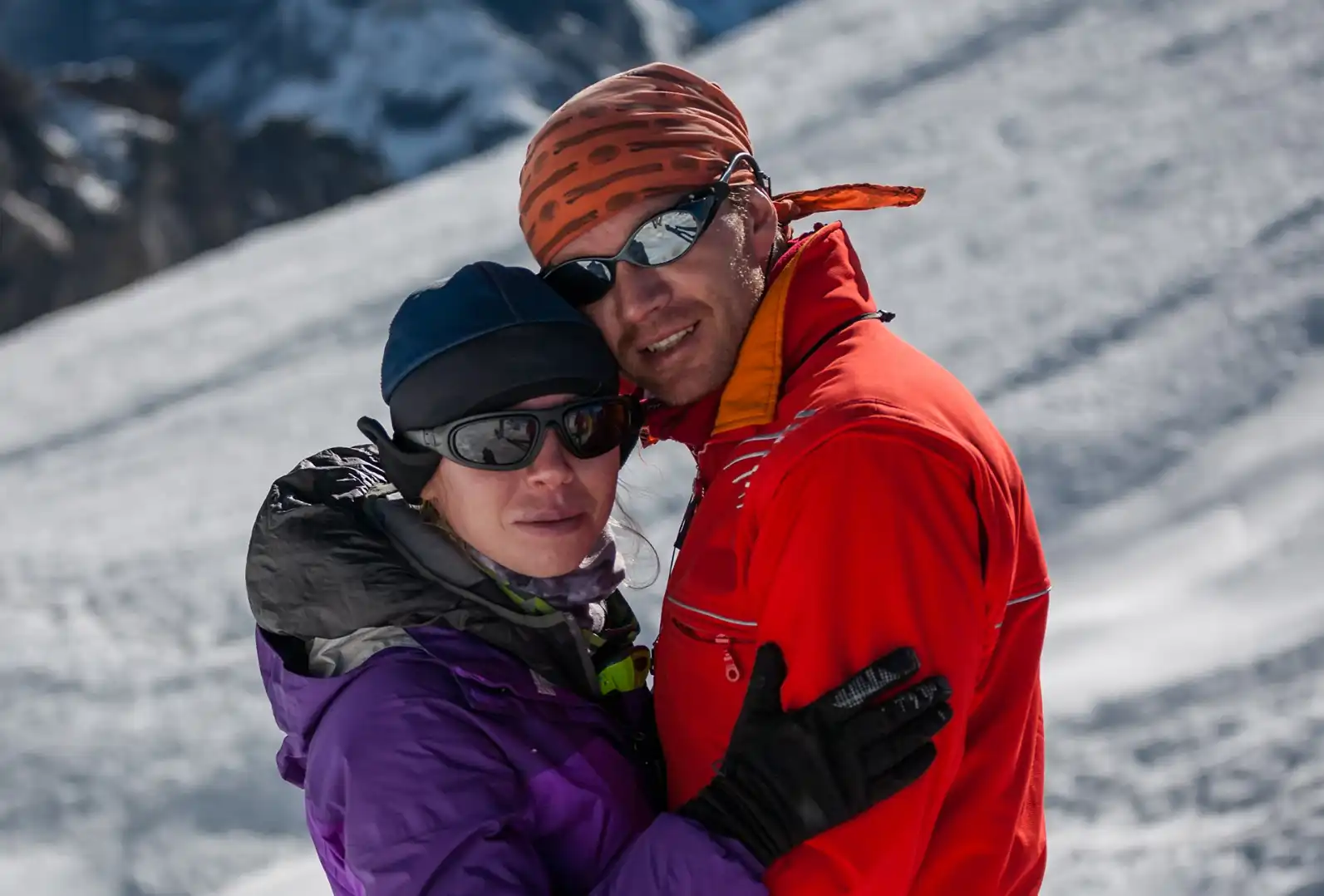
Opt for wraparound models that shield against the intense light reflected off the snow.
Face Protection: Facing windy and snowy conditions calls for a face mask or balaclava to guard against frostbite and windburn. For additional warmth and neck protection, scarves or neck gaiters are advisable.
Navigational and Everest Base Camp Packing List
The challenging and rewarding Everest Base Camp (EBC) trek necessitates the right navigational tools and trekking equipment. These essentials not only guarantee safety but also enrich the trekking experience.
Navigational Tools
Maps: Trekkers find an indispensable resource in a detailed topographic map of the Everest region. Such maps facilitate terrain understanding, landmark location, and effective route planning.
Compass: A reliable compass stands out as a vital navigation aid that is useful even in the digital age. Its lightweight, no power requirement, and all-weather functionality establish it as a dependable route-finding partner.
GPS Devices: GPS devices prove invaluable in the remote expanse of EBC, offering detailed maps, waypoint functionality, and real-time tracking. They shine particularly when visibility drops or when navigating off the established trails.
Trekking Equipment
Trekking Poles: Trekking poles play a key role in lessening the strain on knees and legs, especially during downhill walks. They add stability over rough terrains and assist in keeping a steady rhythm and pace.
Backpacks: Essential for hauling supplies and gear, a sturdy and well-fitting backpack, typically between 50-65 liters, is essential.
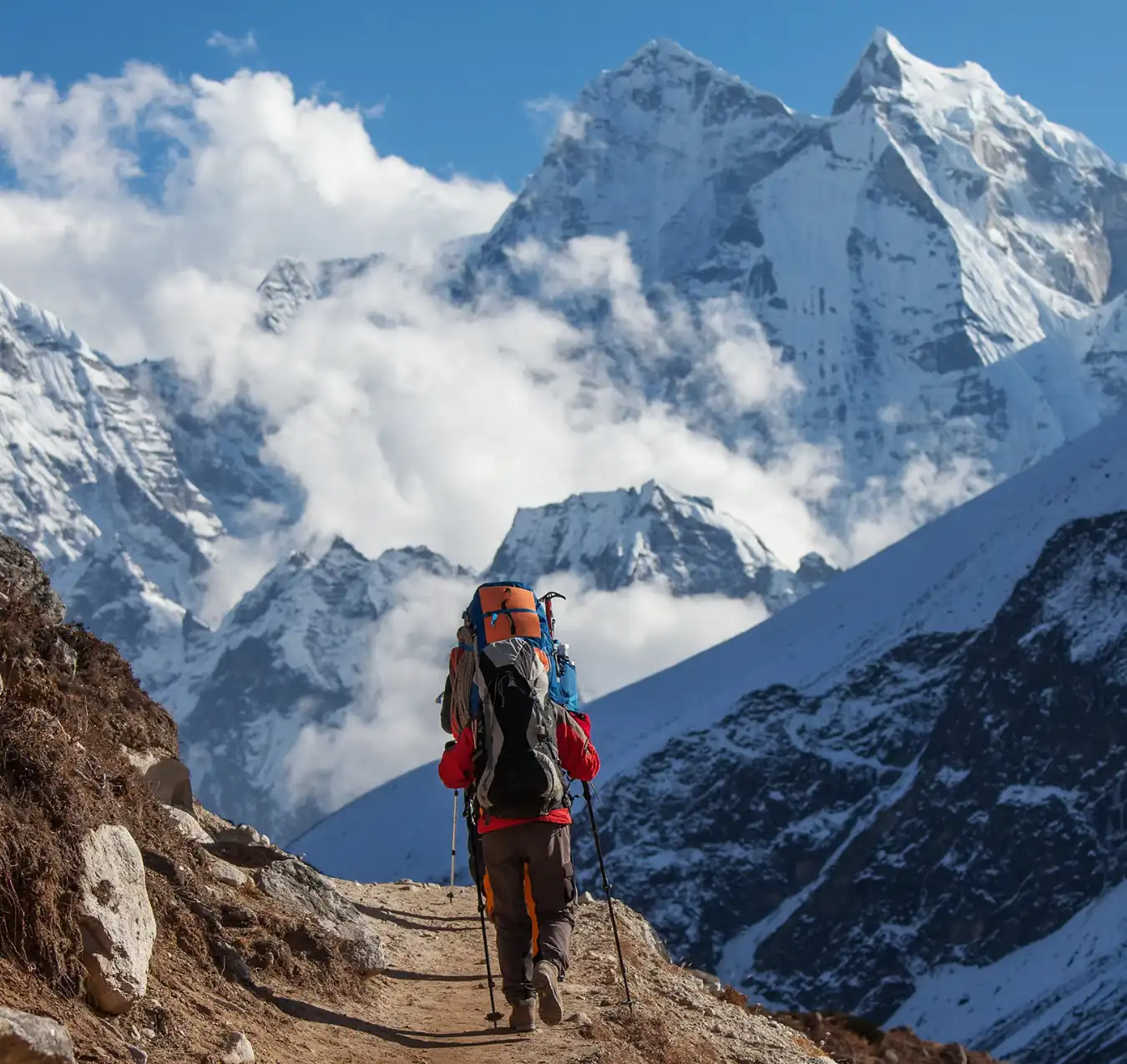
Its adjustable straps and supportive waist belt ensured even weight distribution and increased carrying comfort.
Sleeping Bags: The freezing nights at high altitudes necessitate a high-quality sleeping bag rated for sub-zero temperatures. Selecting a sleeping bag that meets the trek’s lowest temperature demands, possibly supplemented with a liner, ensures warmth and cleanliness.
Health and Safety Supplies
On the Everest Base Camp (EBC) trek, prioritizing health and safety is essential. Trekkers must equip themselves with a comprehensive first-aid kit, the necessary medications, and effective water purification methods to ensure a secure and healthy expedition.
First-Aid Kit Essentials
Include the following in a thorough first-aid kit:
- Bandages and Gauze: Cover and protect wounds or blisters with bandages and gauze of various sizes.
- Antiseptic Wipes and Creams: Use these to clean wounds and prevent infections.
- Pain Relief Medication: Ibuprofen or acetaminophen helps relieve pain or reduce fever.
- Anti-inflammatory Drugs: These reduce swelling and treat muscle strains.
- Blister Treatments: Moleskin or blister pads aid in blister prevention and care.
- Allergy Medication: Carry antihistamines to treat allergic reactions.
- Tape and Scissors: Secure bandages and cut gauze with tape and scissors.
- Thermometer: Monitor fever or body temperature using a thermometer.
- Tweezers and Safety Pins: Remove splinters and secure bandages with tweezers and safety pins.
Medications and Altitude Sickness Prevention
- Altitude Sickness Medication: Use Acetazolamide (Diamox) to prevent and treat altitude sickness symptoms.
- Antibiotics: Treat bacterial infections, especially gastrointestinal issues, with antibiotics.
- Rehydration Salts: Maintain hydration levels during diarrhea or dehydration with rehydration salts.
- Personal Prescriptions: Ensure you carry sufficient personal prescription medications for the trip.
Water Purification Methods
Ensuring safe drinking water is vital to prevent waterborne illnesses:
- Boiling: Boil water for at least one minute to kill bacteria and viruses effectively.
- Water Purification Tablets: Use tablets containing iodine or chlorine dioxide to purify water, effective against most pathogens.
- Portable Water Filters: Filter bacteria and protozoa from water using portable filters, which are ideal for stream or lake water.
- UV Light Purifiers: Purify water quickly and effectively by using ultraviolet light to kill or inactivate microorganisms.
Nutrition and Hydration
Sustaining energy and health with appropriate nutrition and hydration is vital during the Everest Base Camp trek.
What Food to Pack
Energy Bars: Ideal for quick refueling on long treks, energy bars are compact and rich in calories.
Snacks: Nuts, dried fruits, and trail mix provide balanced nutrition and energy and are easy to carry.
Meal Ideas: Lightweight and simple-to-prepare freeze-dried meals require just hot water and come in various flavors, keeping dining interesting. Whole-grain pasta, rice dishes, and soups also provide essential carbohydrates and warmth.
Hydration Strategies
Water Bottles: Essential for the trek, durable water bottles, particularly insulated ones, keep water from freezing in low temperatures.
Hydration Bladders: For continuous hydration, hydration bladders give easy water access, eliminating the need to stop and unpack.
Technical Gear and Accessories
Enhancing the trekking experience, especially for content creators, requires the right technical gear and accessories.
Headlamps: Vital for pre-dawn or post-dusk treks, reliable headlamps with adjustable brightness and red light mode help preserve night vision.
Batteries and Chargers: Carrying extra batteries and portable chargers is important to ensure all devices remain powered, especially solar chargers, which are a good option for extended treks in remote locations.
Cameras: Capturing EBC’s stunning landscapes necessitates a durable, high-quality camera capable of handling various lighting conditions.
Lenses: While a versatile zoom lens suits most needs, wide-angle lenses are great for landscapes, and telephoto lenses help capture distant objects.
Memory Cards: Carrying enough high-capacity memory cards ensures ample storage for high-resolution photos and videos, with fast write speeds being advantageous.
Personal Items and Toiletries
Bringing the right personal care items ensures both comfort and hygiene throughout the trek.
- Sunscreen: Protect your skin from the intense UV rays at high altitudes with high SPF sunscreen.
- Lip Balm: Prevent chapped lips using a lip balm that includes sun protection.
- Personal Hygiene Products: Include essentials like toothpaste, toothbrush, biodegradable soap, and wet wipes for daily cleanliness.
- Towels: Use lightweight, compact, quick-dry towels for efficient after-wash drying.
- Quick-Dry Clothing: Choose clothing that dries quickly and wicks away moisture from the skin.
- Laundry Essentials: Carry biodegradable laundry soap for hand-washing clothes and a small clothesline, or opt for quick-dry garments to simplify laundry.
Documentation and Money Management
Proper management of documentation and finances facilitates a smooth trek.
- Passport: Make sure your passport remains valid for at least six months after your travel dates.
- Permits: Secure all necessary trekking permits for the Everest region in advance.
- Necessary Documentation: Maintain copies of crucial documents, such as insurance policies and emergency contacts.
- Currency Exchange: Convert enough money into Nepalese Rupees before the trek begins.
- Credit Cards: Keep a credit card on hand for emergencies, but primarily use cash since many trial locations do not accept cards.
- Cash Management: Stash cash in various locations to prevent total loss in case of theft.
Packing Tips and Tricks
Smart packing enhances the trekking experience, making the trek smoother and more enjoyable.
How to Pack Efficiently for a Multi-day Trek
- Identify and list essential items to prevent overpacking.
- Organize your gear using packing cubes or compression sacks to reduce space.
Weight Distribution and Managing Pack Weight
- Evenly distribute the weight in your backpack for balance and less strain.
- Position the heaviest items near your back and at the center for better stability and comfort.
Conclusion
For your Everest Base Camp trek, pack layers (base, mid, outer), sturdy hiking boots, trekking poles, a first-aid kit, medications for altitude sickness, personal hygiene items, quick-dry garments, ample food, and water purification tools. Include navigational aids and key technical equipment like a camera and headlamp.
Safeguard your documents, wisely handle your finances, and focus on efficient packing to balance weight. The trek to Everest Base Camp demands both physical and mental readiness. Wishing you a trek filled with stunning scenery, personal triumphs, and safe passage. Enjoy a memorable adventure at Everest Base Camp!
